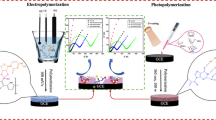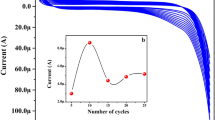Abstract
Tofacitinib citrate (TOF) is a Janus kinase-3 inhibitor used for rheumatoid arthritis treatment. In this study, a molecularly imprinted polymer (MIP)–based sensor was produced using acrylamide as the functional monomer via photopolymerization technique for the electrochemical determination of TOF. This study is the first one to explain the electrochemical determination of TOF with a highly selective MIP-based sensor. The surface characterization of the MIP-based sensor was performed with scanning electron microscopy and energy-dispersive X-ray spectroscopy methods, and it was expanded with electrochemical characterization by cyclic voltammetry and electrochemical impedance spectroscopy (EIS) methods. TOF determination was performed using differential pulse voltammetry (DPV) and EIS methods in standard solution and spiked serum sample in the linear range between 1×10−11 M and 1×10−10 M. Very low limit of detection and limit of quantification values were found, confirming the sensitivity of the sensor. Recovery analysis with spiked serum and tablet samples verified the sensor’s accuracy and applicability using DPV and EIS methods. The selectivity of the sensor was confirmed with imprinting factor and interference studies, and the sensor performance was controlled using non-imprinted polymer for comparison at every step.
Graphical Abstract





Similar content being viewed by others
Data availability
The datasets generated during and/or analysed during the current study are available from the corresponding author on reasonable request.
References
Deane KD, El-Gabalawy H (2014) Pathogenesis and prevention of rheumatic disease: focus on preclinical RA and SLE. Nat Rev Rheumatol 10:212–228. https://doi.org/10.1038/nrrheum.2014.6
Chough C, Joung M, Lee S et al (2018) Development of selective inhibitors for the treatment of rheumatoid arthritis: (R)-3-(3-(Methyl(7H-pyrrolo[2,3-d]pyrimidin-4-yl)amino)pyrrolidin-1-yl)-3-oxopropanenitrile as a JAK1-selective inhibitor. Bioorganic Med Chem 26:1495–1510. https://doi.org/10.1016/j.bmc.2018.01.021
Jang SH, Ju JH (2021) Janus kinase inhibitors for the treatment of rheumatoid arthritis. J Korean Med Assoc 64:105–108. https://doi.org/10.5124/jkma.2021.64.2.105
Siva B, Kiran S, Raja S (2018) Rp-Hplc method development and validation for the quantification of tofacitinib. Res J Life Sci Bioinformatics, Pharm Chem Sci 4:646–653. https://doi.org/10.26479/2018.0404.57
Sharma K, Giri K, Dhiman V et al (2015) A validated LC-MS/MS assay for simultaneous quantification of methotrexate and tofacitinib in rat plasma: application to a pharmacokinetic study. Biomed Chromatogr 29:722–732. https://doi.org/10.1002/bmc.3348
Yilmaz H, Cobandede Z, Yilmaz D et al (2020) Monitoring forced degradation of drugs using silica coated AgNPs with surface-enhanced Raman scattering. Talanta 214:120828. https://doi.org/10.1016/j.talanta.2020.120828
Budak F, Cetinkaya A, Kaya SI et al (2023) Sensitive determination and electrochemical evaluation of anticancer drug tofacitinib in pharmaceutical and biological samples using glassy carbon and boron-doped diamond electrodes. Diam Relat Mater 133:109751. https://doi.org/10.1016/j.diamond.2023.109751
Ozkan SA, Kauffmann J-M, Zuman P (2015) Electroanalysis in biomedical and pharmaceutical sciences. Springer, Berlin, Heidelberg
Mehmeti E, Stanković DM, Ortner A et al (2017) Highly selective electrochemical determination of phlorizin using square wave voltammetry at a boron-doped diamond electrode. Food Anal Methods 10:3747–3752. https://doi.org/10.1007/s12161-017-0935-x
Çorman ME, Cetinkaya A, Ozcelikay G et al (2021) A porous molecularly imprinted nanofilm for selective and sensitive sensing of an anticancer drug ruxolitinib. Anal Chim Acta 1187:339143. https://doi.org/10.1016/j.aca.2021.339143
Çorman ME, Ozcelikay G, Cetinkaya A et al (2022) Metal-organic frameworks as an alternative smart sensing platform for designing molecularly imprinted electrochemical sensors. TrAC - Trends Anal Chem 150:116573. https://doi.org/10.1016/j.trac.2022.116573
Graniczkowska K, Pütz M, Hauser FM et al (2017) Capacitive sensing of N-formylamphetamine based on immobilized molecular imprinted polymers. Biosens Bioelectron 92:741–747. https://doi.org/10.1016/j.bios.2016.09.083
Crapnell RD, Dempsey-Hibbert NC, Peeters M et al (2020) Molecularly imprinted polymer based electrochemical biosensors: overcoming the challenges of detecting vital biomarkers and speeding up diagnosis. Talanta Open 2:100018. https://doi.org/10.1016/j.talo.2020.100018
Sulym I, Cetinkaya A, Yence M et al (2022) Novel electrochemical sensor based on molecularly imprinted polymer combined with L-His-MWCNTs@PDMS-5 nanocomposite for selective and sensitive assay of tetracycline. Electrochim Acta 430:141102. https://doi.org/10.1016/j.electacta.2022.141102
Irem Kaya S, Cetinkaya A, Bellur Atici E et al (2022) Electrochemical sensing of aclidinium bromide with metal ion-assisted molecularly imprinted films. Microchem J 184:108128. https://doi.org/10.1016/j.microc.2022.108128
Cetinkaya A, Kaya SI, Atici EB et al (2022) A semi-covalent molecularly imprinted electrochemical sensor for rapid and selective detection of tiotropium bromide. Anal Bioanal Chem 2022:8023–8033. https://doi.org/10.1007/s00216-022-04335-6
Aristov N, Habekost A (2015) Cyclic voltammetry - a versatile electrochemical method ınvestigating electron transfer processes. World J Chem Educ 3(2015):115–119 3:115–119. https://doi.org/10.12691/wjce-3-5-2
Ozkan SA, Kauffmann J-M, Zuman P (2015) Electroanalysis in biomedical and pharmaceutical sciences. Springer
International Conference on Harmonization (1995) Validation of analytical procedures: text and methodology. Int. Conf. Harmon. Guidel
Hesham H, Rady M, Hathout RM et al (2022) The skin delivery of tofacitinib citrate using transethosomes and hybridized ethosomes/nanostructured lipid carriers for vitiligo therapy: dermatopharmacokinetics and in vivo assays. Int J Pharm 629:122387. https://doi.org/10.1016/j.ijpharm.2022.122387
Atmakuri S, Nene S, Jain H et al (2023) Topical delivery of tofacitinib citrate loaded novel nanoemulgel for the management of 2,4-dichlorodinitrobenzene induced atopic dermatitis in mice model. J Drug Deliv Sci Technol 80:104145. https://doi.org/10.1016/j.jddst.2022.104145
Acknowledgements
Fatma Budak thanks the financial support from the Council of Higher Education 100/2000 (YOK) under the special 100/2000 scholarship program and TUBITAK under the ARDEB/1004 Ph.D. Scholarship Programs. Ahmet Cetinkaya thanks the financial support from the Council of Higher Education 100/2000 (YOK) under the special 100/2000 scholarship program and the Scientific and Technological Research Council of Turkey (TUBITAK) under the BIDEB/2211-A Ph.D. and ARDEB/1004 Ph.D. Scholarship Programs.
Author information
Authors and Affiliations
Corresponding authors
Ethics declarations
Conflict of interest
The authors declare no competing interests.
Additional information
Publisher’s note
Springer Nature remains neutral with regard to jurisdictional claims in published maps and institutional affiliations.
Supplementary Information
ESM 1:
A molecularly imprinted polymer-based electrochemical sensor for the determination of tofacitinib (DOCX 226 kb)
Rights and permissions
Springer Nature or its licensor (e.g. a society or other partner) holds exclusive rights to this article under a publishing agreement with the author(s) or other rightsholder(s); author self-archiving of the accepted manuscript version of this article is solely governed by the terms of such publishing agreement and applicable law.
About this article
Cite this article
Budak, F., Cetinkaya, A., Kaya, S.I. et al. A molecularly imprinted polymer-based electrochemical sensor for the determination of tofacitinib. Microchim Acta 190, 205 (2023). https://doi.org/10.1007/s00604-023-05790-3
Received:
Accepted:
Published:
DOI: https://doi.org/10.1007/s00604-023-05790-3




